by Ben Zackheim | May 28, 2014 | Book Promotion, Sell your book |
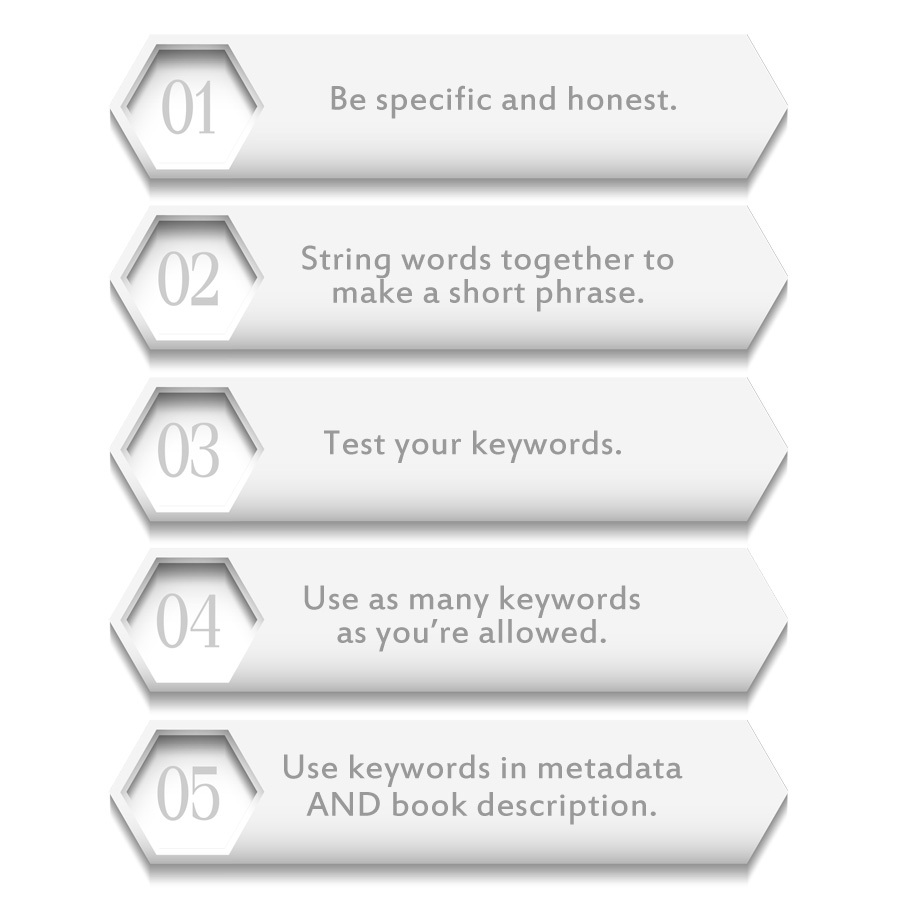
What are keywords? They’re the words you use to describe your book. Sometimes you’ll hear them called keyword phrases, but that just means keywords that are more than one word long. For example, “hero” is a keyword and “android hero” is a keyword phrase.
Amazon asks for keywords.
BN.com asks for keywords.
In fact, every site with media wants them.
But why is it so important to find keywords for your book?
Keywords are a primary way for a store to understand what your book is about. When you give your book a keyword, you’re giving it an identity. After all, “detective” paints a different picture in your head than “cooking.” Keywords are beacons, pings, scents that get picked up by search engines, recommendation bots and, oh yeah… readers.
Keywords are like perfume. If chosen wisely, they make your book more attractive to the right folks. The kind of folks who are so totally into you (and your book).
So how do you find keywords to use for your book?
How do you find keywords that will help your book get visible on the online stores?
1) Be specific and be honest.
Use words that truly describe your book, not what you think will be popular.
And when you choose the keywords, use specific terms like “android hero” instead of “hero”. This will help the book get spotted by folks with specific tastes.
2) String a couple of words together to make a short, clear phrase.
So use “mystery series for kids 9-12” instead of just “kids mystery”. These keyword terms will map well with what customers actually type into the search bar when they’re looking for a book.
Use keywords in the same way a customer would use them. Example: sleuth mysteries, not mysteries sleuth
3) Test your keywords.
Go to the online bookstores where you sell your book.
Type in one of the words you chose for your book. Notice the window that drops down?

Those are suggestions for readers to make their search easier. But it’s also list of suggestions for authors trying to find keywords for their book!
Here’s how.
Scan the list of terms in that drop-down menu. Click on the first one that truly applies to your book. Do you like the results you see for that term? Do those books look like your competition? Then use that term! It applies to your book and it’s popular enough to appear in the drop-down menu — so go for it.
4) On Amazon, be sure to use all seven keywords or short phrases.
Separate them by a comma.
5) Be sure to use your keywords in the book metadata AND in the book description.
If the scent fits, then wear it everywhere! The more you use appropriate keywords on your book’s sales page, the better your chances of connecting to the right customer.
Keep these five tips in mind while you’re prepping your book for sale. You can also follow these tips if you want to find keywords for your existing books. I’ve seen Shirley Link & The Safe Case climb up two popular lists on Amazon just by tweaking the keywords after launch.
Good luck! It can be tough to find keywords for your book that work well. But as Amazon says, “To increase your book’s discoverability on Amazon, you need descriptions and keywords that accurately portray your book’s content and use the words customers will use when they search. Along with factors like sales history and Amazon Best Sellers Rank, relevant keywords can boost your placement in search results on Amazon.com. ”
You can’t be everything to everybody. That’s a recipe for failure. So choose your scent and find your book lovers!
Other writer’s advice on how to find keywords for books:
KDP Forum Post
Lindsay Buroker
The Metanautics Department (some interesting thoughts on using Google’s keyword tool to recognize term popularity in the general population)
By Ben Zackheim
You might also like:
How to write an author bio that sells books
Choose the best genre for your book on Amazon

by Ben Zackheim | May 22, 2014 | Book Promotion, Sell your book, Writing |
Many of us think in words. Authors are like that. Our thoughts take on a distinct inner voice — dependent on mood, muse and cups of coffee.
So when we’re faced with the option of building a book trailer, with words and pictures and animations… well, it’s daunting.
With an NYU Film School education and several years of playing the Hollywood game, I’ve set out to craft a trailer for my upcoming series, The Camelot Kids. I’m delighted with it so far, so I thought I’d share some basic rules that have helped me focus.
Here are my impressions of what works, what doesn’t and how to avoid the common mistakes I spot in book trailers every day.
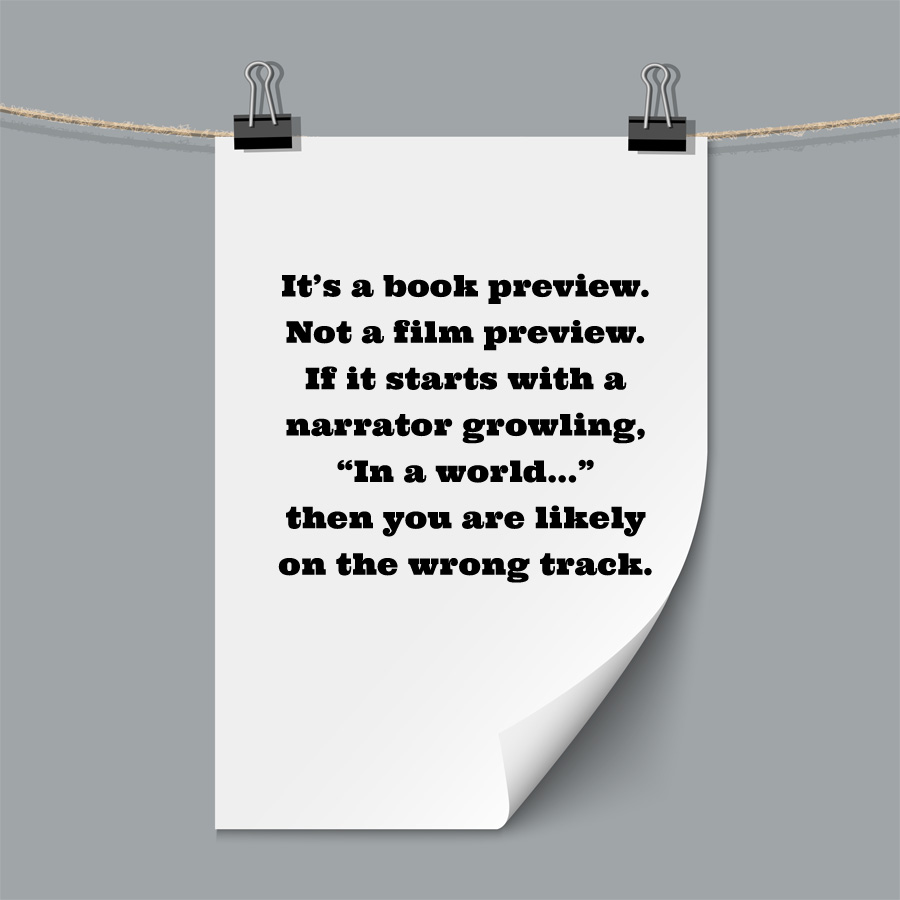

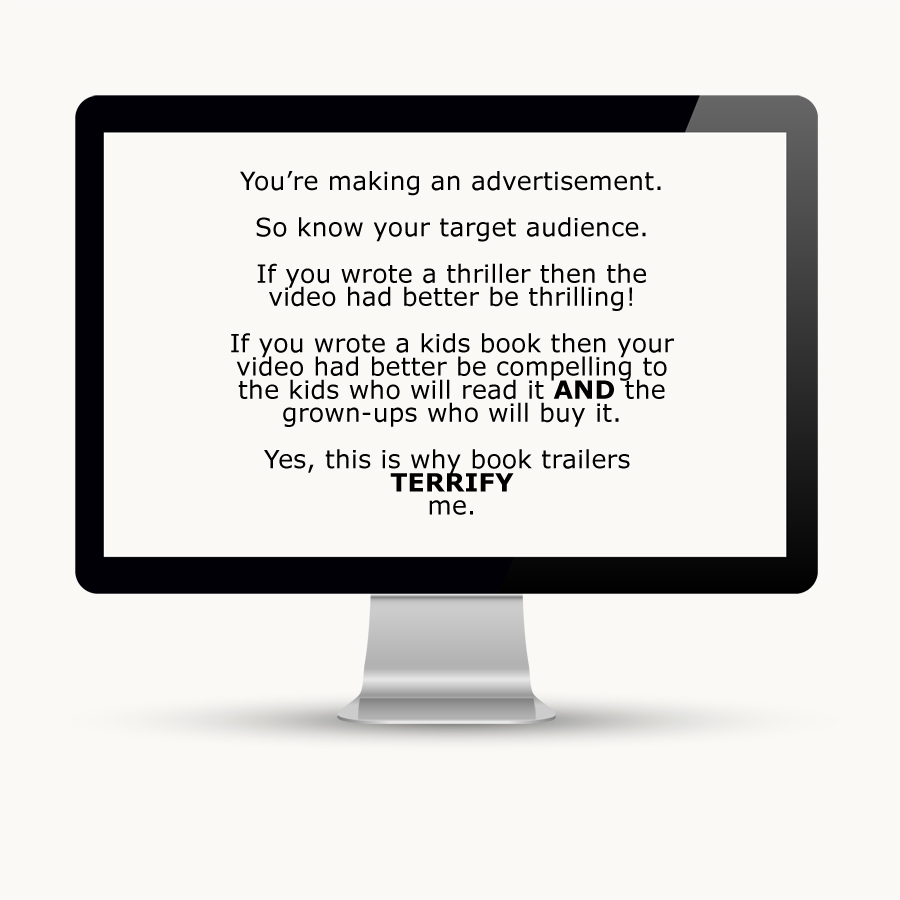

Here are some resources for you to dig into:
Tools for book trailer creation
Adobe Voice for iPad
A spectacular tool. I don’t use that word lightly. That’s the term I save in my quiver for special occasions.
The app on the iPad does everything and does it well. You can make a slick presentation within minutes. If you want to make a fast, elegant trailer that focuses on your writing style, character voices or humor then Adobe Voice can help you. Oh, and they have tens of thousands of stock images for free. The app adds the correct credit to the end of the video so you’re pretty safe.
I can’t recommend this app enough.
Prezi
Some quality book trailers have been done with Prezi tools. Like Adobe Voice, the service will help you look slick. But unlike Adobe Voice, you don’t have simple and searchable access to free, accredited images.
Graphicstock and BigStock are (as of this writing) offering a free one week trial to their library of images. You need to give a credit card to get access, but you can cancel if you don’t think the service gives you enough value.
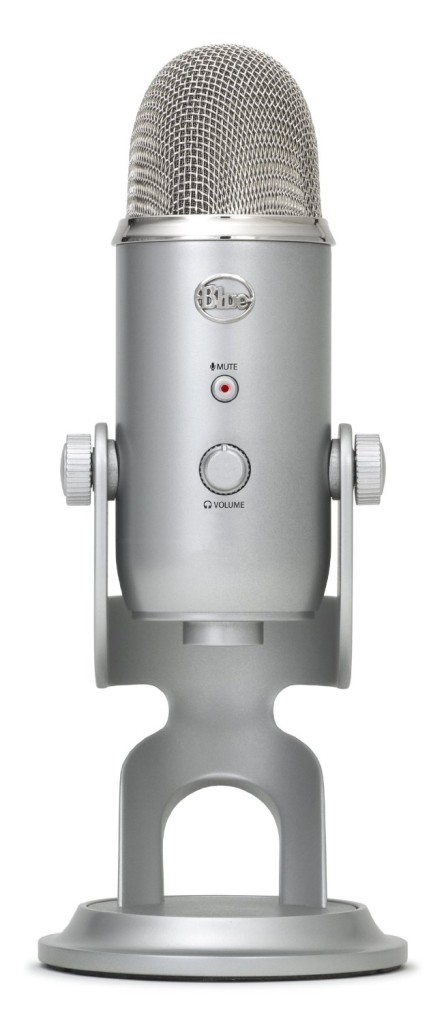 If you decide that voice is a critical component of your trailer, then you really can’t go wrong with Blue’s Yeti mic. It looks great and sounds even better. While the sensitivity can be high it’s nothing that can’t be adjusted for with a little distance from the mic.
If you decide that voice is a critical component of your trailer, then you really can’t go wrong with Blue’s Yeti mic. It looks great and sounds even better. While the sensitivity can be high it’s nothing that can’t be adjusted for with a little distance from the mic.
Book trailers that work
Fantastic book trailers and the reasons they’re so good
7 Brilliant Book Trailers
A funny piece in The New Yorker about book trailers
Have you made a book trailer? What do you think of book trailers? Let us know in the comments!
By Ben Zackheim
You might also like:
How to write an author bio that sells books
Choose the best genre for your book on Amazon
by Ben Zackheim | May 13, 2014 | Book Promotion, Sell your book |
Welcome to the first in a series of video tutorials!
The series will cover best practices for today’s author. I don’t want the information to be useful to one type of writer or another. I don’t care if you’re self-published, small press-backed, big publisher-backed… good info is good info. Authors are in this thing together. The more we share our common experiences, the better we’ll steer our own boats.
Let me know what you think in the comments!
by Ben Zackheim | May 12, 2014 | Book Promotion, Sell your book |
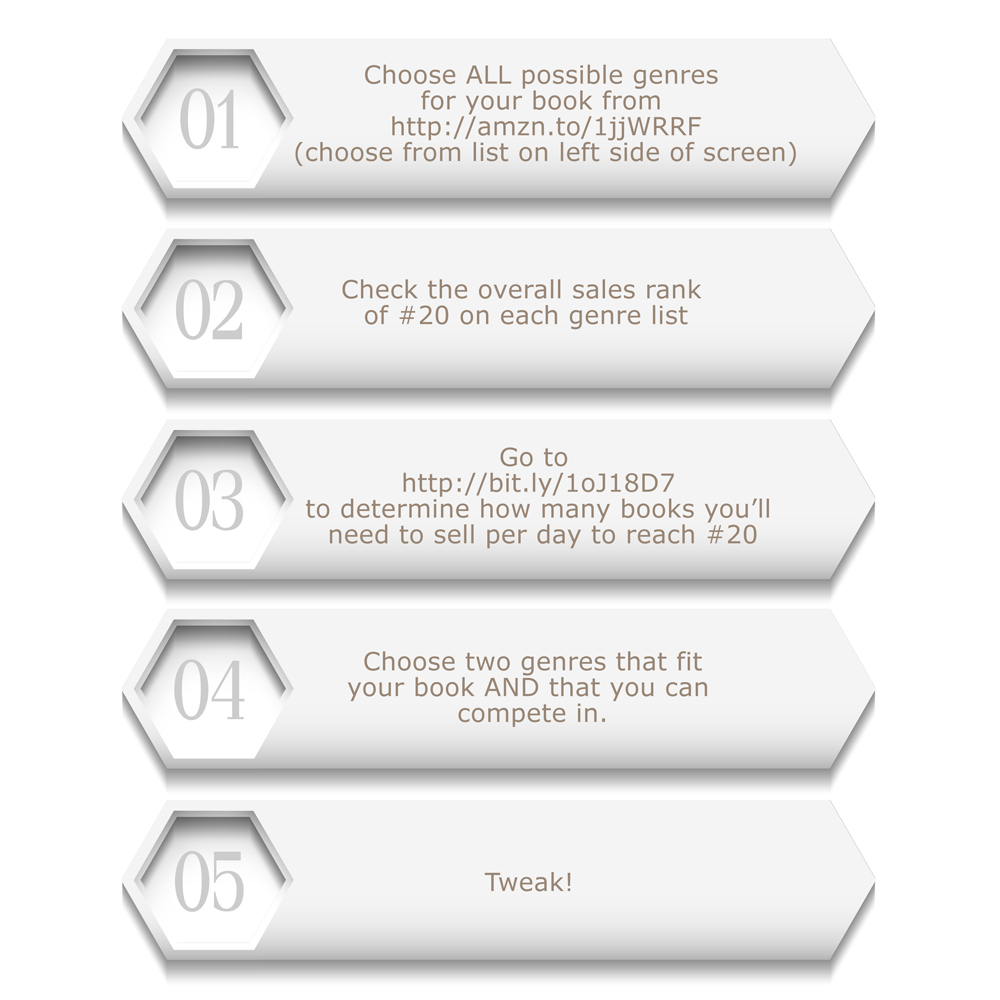
Cheat sheet. Use it once you’ve read the rest of this post!
In my last post, I covered the general rules of choosing the right genre for your book. I spoke briefly about Amazon’s categories. I’ll go into more details now.
The ground rules for Amazon categories are simple:
Every genre on Amazon gets to have its own tidy list of popular titles.
Each of these lists is often visited by fans of those genres.
Amazon scours their popularity lists for books to promote.
So how do you show up on a popular Amazon list?
Choose the right genre when you publish your book on Amazon.
Once you’ve identified which genres you belong in, you need to decide which genre is easiest for you to get in the Top 20. We’re shooting for the Top 20 because that means your book would show up on the first page of that genre’s Amazon page.
Good place to be…
After we find the easiest genre to place in, we’ll shoot for a tougher genre. Just to keep things interesting!
How to choose the right genre for your book on Amazon
Okay, let’s say we write a Mystery ebook for kids with a female detective (like oh, say, Shirley Link). Here are some of the possible categories on Amazon. I dug these up by rummaging through Amazon’s genre lists (seen on the left hand side of this page)
Kindle ebooks/Children’s ebooks/Mysteries & Detectives
Kindle ebooks/Children’s ebooks/Mysteries & Detectives/Detectives
Kindle ebooks/Children’s ebooks/Action & Adventure
Kindle ebooks/Children’s ebooks/Literature & Fiction/Beginner Readers
Kindle ebooks/Literature & Fiction/Chapter Books
Kindle ebooks/Literature & Fiction/Women’s Fiction/Mystery, Thriller & Suspense/Women Sleuths
Any of these genres would work for the book. So how do we choose which genre we can get to #20 in?
Using Theresa Ragan’s sales estimator, I get a ballpark idea of how many books I’d need to sell to crack the top 20 of each possible genre.
So the #20 book in Kindle ebooks/Children’s ebooks/Mysteries & Detectives/Detectives is Nancy Drew & The Bungalow Mystery.
But, more important to us is the book’s overall Kindle rank of 39,589 (see image below).
Checking Theresa’s sales estimator, this means the book sells between 3-15 copies per day.
Nancy Drew: The Bungalow Mystery sales rank info from the book’s product page on Amazon:

On the other hand, Kindle ebooks/Children’s ebooks/Mysteries & Detectives is a tough one. The 20th ranked book has an overall Kindle sales rank of 3,239. This means the book sells between 30-50 books per day.
Spirit Animals Book 1 sales rank info from the book’s product page on Amazon:

I think I can manage to sell 3-15 books per day, but 30-50 will take some ingenuity. If I can find a way to crack the tough Action & Adventure Top 20 list then that will mean much more exposure to more people. I’m willing to claw my way up that genre’s listings over the long haul. One good sales day could be a game changer.
Conclusion
It’s fine to choose low-popularity genres for your picks. You’re more likely to be seen by fans of those genres if you rank high! But don’t be afraid to experiment if you’re not happy with sales. Yes, it’s possible to lose sales because you’ve changed genres, but if you do it with a marketing plan to back it up then you can gain crucial customer knowledge.
If you have any questions, please ask them in the comments. Don’t forget to use the cheat sheet above. And pass it on to a writer friend.
Thanks for reading!
By Ben Zackheim
Helpful tool: Sign up for EBookTracker to get details on any book’s ranking over time. The tool won’t help you see actual sales, but it will give you insights around your favorite genre’s movers and shakers.
You might also like:
Amazon has a bridge to sell ya!
The $1.1 Million question: Is KDP Select worth it?

by Ben Zackheim | Apr 30, 2014 | Book Promotion, Sell your book, Writing |
How important is book genre?
Here’s a worst-case scenario:
1974: Stephen King’s first novel, Carrie, is released. The publisher lists it as a Biography by accident. The book sits on the wrong shelf across the country.
2014: No one knows who Stephen King is.
Yes, that’s an exaggeration, but when you choose the wrong genre for your books on Amazon you’re choosing the wrong shelf. Simply put, that could destroy the book’s chances.
Luckily, we can change genres as often as we change writing software. Every online retailer allows you to genre-hop until you find your right audience.
5 simple steps you can take to choose the right genre:
1) Go to a bookstore!
Okay, this is going to sound trite. If it does, then head to #2. But it worked for me! If your book was inspired by a particular novel or author, then go find them on the shelf.
Now imagine that your book sits next to it.
Does it feel right?
It sounds loopy, but it really works! Especially if your book is a mix of many genres.
Click on the genre you chose in #1 and study the sub-genres on BISG.
Then bookmark BISG! Why? Because new genres pop up every year. The BISG site is the most transparent method of spotting a new mainstream, “official” market for your work.
And guess what? Most booksellers comply with the BISG list!
3) Head to the major online booksellers and find your niche.
These sites are your stores. You get a place on the shelf. You get a small display. You get a few seconds to make the sale. So know your store.
Luckily, with the BISG list you whittled down the choices so you don’t need to dig as much now that you’re about to dive into the morass of online bookstore genre lists! How big a mess are they? Well, here’s the Mystery genre list of four top online stores.
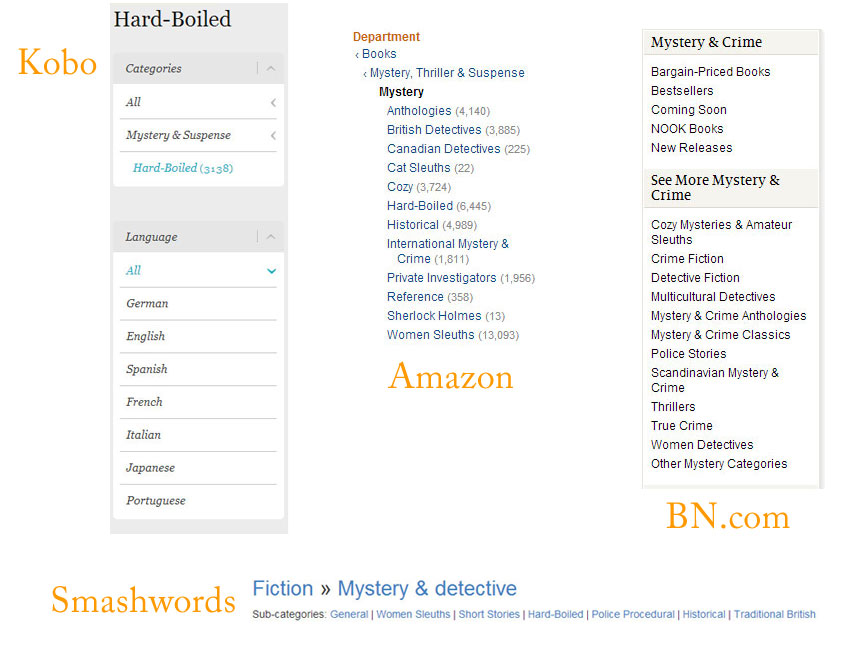
And check out this small taste of what genres each store offers: (all lists are from April, 2014)
Amazon genre list
[showhide type=”genrelist” more_text=”>>Click this link to show the Amazon genre list” less_text=”>>Click this link to hide Amazon genre list” hidden=”yes”]
#s in parentheses are the total number of titles in that genre
Arts & Photography (939,077)
Biographies & Memoirs (691,601)
Business & Money (1,967,372)
Calendars (136,574)
Children’s Books (1,110,182)
Christian Books & Bibles (652,410)
Comics & Graphic Novels (410,241)
Computers & Technology (496,343)
Cookbooks, Food & Wine (187,337)
Crafts, Hobbies & Home (430,882)
Education & Reference (4,512,483)
Engineering & Transportation (710,286)
Gay & Lesbian (52,727)
Health, Fitness & Dieting (610,932)
History (3,805,653)
Humor & Entertainment (453,318)
Law (566,246)
Literature & Fiction (3,178,315)
Medical Books (771,156)
Mystery, Thriller & Suspense (272,265)
Parenting & Relationships (165,447)
Politics & Social Sciences (1,597,281)
Religion & Spirituality (1,271,853)
Romance (435,075)
Science & Math (1,518,315)
Science Fiction & Fantasy (287,324)
Self-Help (309,223)
Sports & Outdoors (254,091)
Teen & Young Adult (279,009)
Travel (414,616)
[/showhide]
Barnes & Noble genre list
[showhide type=”genrelist2″ more_text=”>>Click this link to show the Barnes & Noble genre list” less_text=”>>Click this link to hide the Barnes & Noble genre list” hidden=”yes”]
Art, Architecture & Photography
Bibles & Bible Studies
Biographies
Business & Money
Children’s Books
Computing & Internet
Cookbooks, Food & Wine
Crafts & Hobbies
Education & Teaching
Fiction & Literature
Graphic Novels
Health & Fitness
History
Home & Garden
Humor
Libros en español
Medicine
Mystery & Crime
Nonfiction
Politics & Current Events
Psychology
Religion
Reference
Romance
Science & Nature
Science Fiction & Fantasy
Self-Improvement
Sports & Adventure
Travel
[/showhide]
Kobo genre list
[showhide type=”genrelist3″ more_text=”>>Click this link to show the Kobo genre list” less_text=”>>Click this link to hide the Kobo genre list” hidden=”yes”]
BIOGRAPHY & MEMOIR
Artists, Architects & Photographers
Business
Composers & Musicians
Entertainment & Performing Arts
Historical
Literary
Philosophers
Political
Reference
Religious
Royalty
Sports
BUSINESS & FINANCE
Accounting
Business Reference
Career Planning & Job Hunting
Economics
Entrepreneurship & Small Business
Finance & Investing
Human Resources & Personnel Management
Industries & Professions
Management & Leadership
Marketing & Sales
Personal Finance
COMICS & GRAPHIC NOVELS
Anthologies
Contemporary Women
Crime & Mystery
Erotica
Fantasy
Gay & Lesbian
Historical Fiction
Horror
Literary
Manga
Media Tie-In
Non-Fiction
Religious
Romance
Science Fiction
Superheroes
FICTION & LITERATURE
Action Suspense
Anthologies
Classics
Drama
Essays & Letters
Fiction – Young Adult
Historical
Horror
Humorous
LGBT
Literary
Literary Theory & Criticism
Movie & Television Tie-Ins
Poetry
Psychological
Religious
Short Stories
Thrillers
Westerns
KIDS & TEENS
ABCs, 123s
Animals
Beautiful and Interesting
Comics, Graphic Novels & Manga
Creative Kids
Fiction
Français, Español and more
Knock knock, Who’s Funny?
My Family, My Feelings, My Friends
Natural World
People and Places
Read-Along
Religion
School Tools
Sports and Recreation
Technology
Teen
Two Wheels, Four Wheels, No Wheels
MYSTERY & SUSPENSE
Cozy Mysteries
Espionage
Hard-Boiled
Historical Mystery
International
Legal
Police Procedural
Technological
Thrillers
Traditional British
Women Sleuths
NONFICTION
Art & Architecture
Computers
Entertainment
Family & Relationships
Food & Drink
Health & Well Being
History
Home & Garden
Reference & Language
Religion & Spirituality
Science & Nature
Social & Cultural Studies
Sports
Travel
ROMANCE
Contemporary
Erotica
Harlequin
Historical
Inspired Romance
Paranormal
Romantic Suspense
Science Fiction & Fantasy
SCI FI & FANTASY
Fantasy
High Tech
Historical
Horror
Science Fiction
Space Opera
Steampunk
[/showhide]
Smashwords genre list
[showhide type=”genrelist4″ more_text=”>>Click this link to show the Smashwords genre list” less_text=”>>Click this link to hide the Smashwords genre list” hidden=”yes”]
Fiction
Adventure
African American fiction
Anthologies
Children’s books
Christian
Classics
Cultural & ethnic themes
Drama
Fantasy
Gay & lesbian fiction
Graphic novels & comics
Historical
Holiday
Horror
Humor & comedy
Inspirational
Literary collections
Literature
Mashups
Mystery & detective
Poetry
Romance
Science fiction
Themes & motifs
Thriller & suspense
Women’s fiction
Young adult or teen
Non-Fiction
Antiques & Collectibles
Art, Architecture, Photography
Biography
Business & Economics
Career Guides
Children’s Books
Comics (nonfictional)
Computers and Internet
Cooking, Food, Wine, Spirits
Education and Study Guides
Engineering, trades, and technology
Entertainment
Gay and Lesbian
General reference
Health, wellbeing, & medicine
History
Home and Garden
Inspiration
Language Instruction
Law
Music
New Age
Parenting
Philosophy
Politics and Current Affairs
Psychology
Publishing
Reference
Relationships and Family
Religion and Spirituality
Science and Nature
Self-improvement
Sex and Relationships
Social Science
Sports & outdoor recreation
Transportation
Travel
True Crime
Weddings
[/showhide]
The lists above don’t include all sub-genres! So yeah, there are a lot of options. Again, BISG will help you focus.
4) Choose every single genre that makes sense.
Every. Single. One.
That’s probably a lot, and that’s okay. Write the list down somewhere safe. You’ll need it for #5.
Each online seller allows you to choose a different number of genres. Choose the genres that feel right. Or choose the genres that solid data supports.
Important note: Make sure your honest with yourself and choose a genre that actually fits. Just because your book includes a cameo of a handsome vampire doesn’t make it a New Adult Paranormal Romance. If you choose the wrong genre for your book you will hear from the readers — with bad reviews (see #5 for my experience).
Important note #2: Some bookstores don’t allow you to choose the precise genre you want. In this case, write to their support team and tell them you’d like placement in a certain genre. They’ll do so, but it may take a while.
5) Measure performance and make changes
This might be controversial advice, but it makes sense. If you don’t think your book is finding an audience in the genre you picked, then consider changing to another one.
[blockquote author_name=”” width=”50%” float=”left”]Upside: You might hit the nail on the head.[/blockquote]
[blockquote author_name=”” width=”50%” float=”left”]Downside: You might disrupt any momentum you were getting in the genre (which is info that none of these stores shares with us).[/blockquote]
I changed genres for the Shirley Link series on Amazon from Young Adult Mysteries to Kids Mysteries. I was getting a lot of downloads in Young Adult, but most of my reviews were *enh* to awful because young adults thought my books were too young for them. While I haven’t yet shown in the top seller list on Kids Mysteries, I’ve seen excellent reviews since I made the move.
It’s a tough call, sure. But if your book isn’t moving after a couple of months, try changing one of your sub-genres before you spend cash on a promo.
What tips do you have for genre seekers? Help out a fellow writer in the comments.
By Ben Zackheim
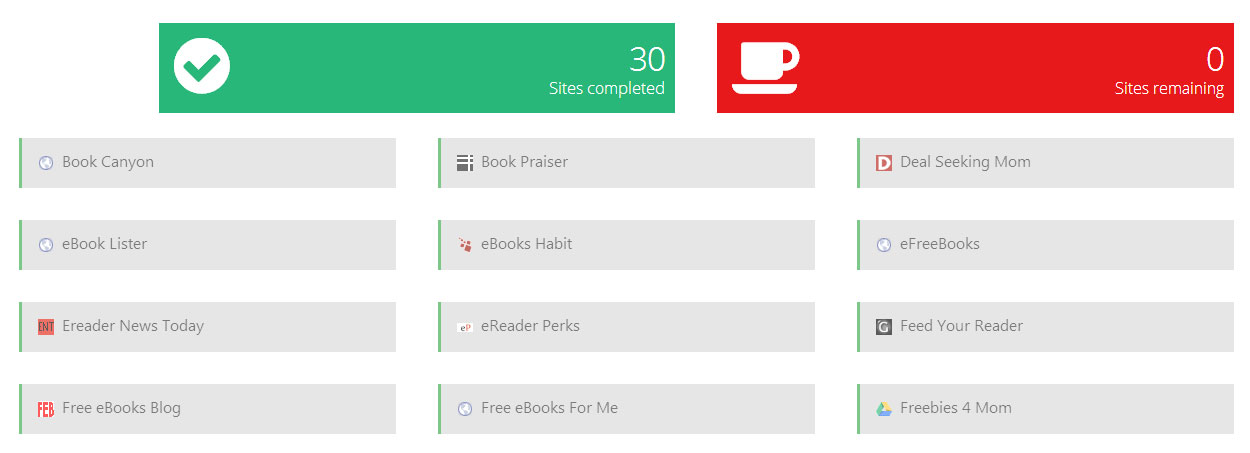
by Ben Zackheim | Apr 23, 2014 | Book Promotion, Sell your book, Writing |
As usual, I’m at my standing desk doing squats (poorly). I’m in the throes of marketing bliss as I find ways to promote my book.
I check on the sales of my book Shirley Link & The Black Cat.
They’re dip-tastic.
Time for a promotion.
So I plan until my brain stem hurts: the right day, the right level of social sharing, the right promotional materials… You know the drill.
Now all I have to do is post my book to the book listing sites! Wheee! So let’s see. That means I get to…
… scour through my bookmarks to find sites that still exist.
… excavate the correct submission page and read through the site rules that run, on average, 4,987 words.
… enter the same information over and over until I hate my name/book title/genre/sub-genre/description…
Of course, even with all of this work, there is no guarantee that my book will actually appear on the promotional site.
Can I lick the floor instead?
So when I heard about Book Marketing Tools’ ebook submission tool I stopped doing my lame squats. Book Marketing Tools promises to let you easily promote your book on 30 of the top free/deal sites. How easy? Like one-click per site. Fifteen minutes from start to finish.
This isn’t like Authors Marketing Club’s tool where they list out the links and send you off to fill out the form to promote your book. It’s a service that promises to make the submissions easy. That’s a promise I’m delighted to take them up on.
How does the ebook submission tool work?
I headed in with high hopes and low expectations. I’ve been burned by promotional tools before.
So I was pleased to find a good-looking site that told me what it did and got me into work-mode fast. The service asks you to enter some basic data about you and your book. It’s the same info you’re usually asked to enter on the deal sites. ASIN, Title, Author, Genre, Author bio. The idea here is that you should only need to enter the data once for all 30 sites.
When you finish with that step, you get this…
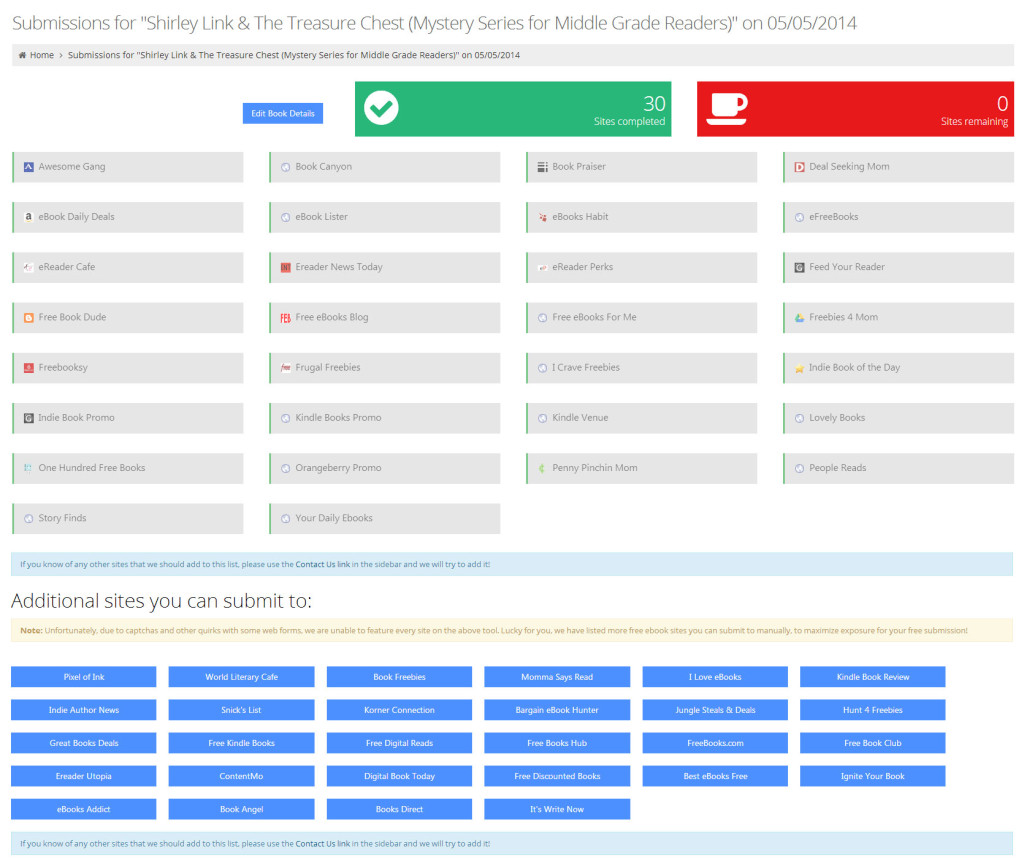
See the list of sites with the light gray backdrops? Those are the ones that you can submit to automatically. All you have to do is click on the first site (Awesome Gang) and a pop-up window appears. You verify the pre-populated info and click on the ‘Next’ button.
Repeat 29 times.
Did it work? Yup. Some of the steps required an extra few seconds of data entry, but the process took only 15 minutes! Fifteen minutes to promote your book on 30 sites. Wow.
I think my favorite part was watching dozens of verification emails flood my inbox one after another.
Unfortunately, the blue-button sites at the bottom of the dashboard screen cannot be filled automatically. They act more like the AMC tool — sending you off to the correct submission pages where you do the heavy lifting. Still, it’s nice to have the list in one place.
With all of its strengths, I’d like to see the tool track two things:
1) Which of the sites under the “Additional sites you can submit to” header did I submit to already? I’d like to check it off my list once I’m done submitting manually.
2) What’s the success rate of the submissions? Did Edreader News Today show my book on promo day, or not? I’d use this service to track my progress if it had the tools.
But won’t the submission sites be angry about this new service? Not if they think it through. I discovered a bunch of sites I’d never heard of before on the dashboard. Besides, when I submit to a promo site I’m not there to browse. I want to submit my book and move on. That’s not the behavior of a valuable visitor. In my opinion, promotional sites should work with Book Marketing Tools to make things as easy as possible for us. It’s a logical way to strengthen their services and their brands.
So yes, the ebook submission tool can help you promote your book to 30 sites in 15 minutes, as advertised. If I could track details of my promotions then Book Marketing Tools could become one of my default browser tabs.
The price is $29 per book promo. That seems a little steep to me, but I might do it to save myself a couple of hours of work.
Give it a try and let us know how it works for you.
By Ben Zackheim
Disclaimer: Book Marketing Tools reached out to me and offered me a $5 credit to test their new tool. I’m posting my experience, which was a good one.







 If you decide that voice is a critical component of your trailer, then you really can’t go wrong with
If you decide that voice is a critical component of your trailer, then you really can’t go wrong with 




